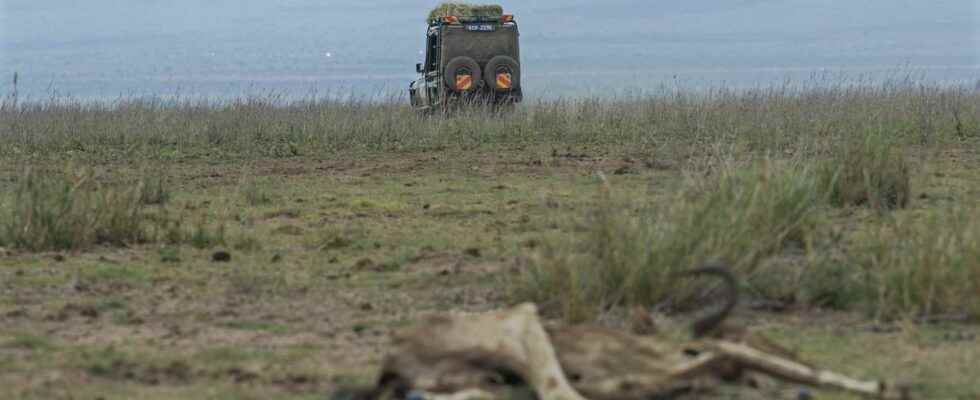At the time of COP15 and while the Horn of Africa has been suffering from insufficient rainfall since the end of 2020, thousands of animals are dying, according to the government.
While COP15, the UN conference on biodiversity opens this Wednesday, December 7 in Montreal with a colossal challenge: to conclude a historic agreement in two weeks, in Amboseli, in southern Kenya, near the border with Tanzania, the earth is dry and cracks underfoot. Not a tall grass on the horizon, the leaves of the emaciated trees are yellowed. Animal carcasses lie along the road. ” The last big rain we had here was in December 2021 Laments Josphat Wangigi Kagai, 37, a Nature Conservancy Service (KWS) ranger who has worked in the park since 2016.
He has just been called by Kelembu Ole Nkuren, a Maasai shepherd who discovered, while grazing his herd, an elephant that had been dead for almost a month. The pachyderm, gutted by raptors and other predators, lies in the vast plain overlooked by the snowy peaks of Kilimanjaro. A fetid smell surrounds the remains of the animal, only seven years old when the life expectancy of elephants is around 60 years. ” This elephant died from drought », Laments Josphat Wangigi Kagai. Using an axe, he then works to remove the animal’s tusks to prevent them from being picked up by poachers. ” For the past few weeks, we’ve been doing this practically every day, this is the first time I’ve seen this, it makes me particularly sad he sighs.
205 elephants, 512 wildebeest, 381 zebras and 12 giraffes died from drought
In Kenya, drought, a consequence of climate change, has plunged at least 4 million people into hunger (out of a population of more than 50 million inhabitants) but also its exceptional wildlife, which makes it a popular tourist destination. According to Tourism Minister Peninah Malonza, 205 elephants, 512 wildebeest, 381 zebras and 12 giraffes had died from the drought between February and October.
In Amboseli, one of the two emblematic parks of the country with that of Masai Mara, the wells are drying up, the pastures are turning into dust. “Some time ago I saw an elephant that was exhausted, I gave it a drink but it was already too late. He collapsed shortly after “says Josphat Wangigi Kagai, saying that zebras and antelopes are the most affected.
“This drought is terrible (…) because everything is disappearing at the moment: zebras, wildebeest, giraffes, and elephants. I have never seen so many dead wild animalsassures Kelembu Ole Nkuren, the Maasai shepherd who spent 35 years of his life in Amboseli. Before the drought you could see herds of elephants roaming this part of the park, they are nowhere to be found today “, he continues. In a remote area of the park, rotting bodies of zebras, buffaloes and antelopes stretch out on the arid ground. Swarms of flies form. “The nearest water point is about thirty kilometers away, it was too far for them“, explains Josphat Wangigi Kagai.
Read alsoA more eco-responsible safari in Africa is possible!
Hay and wells against the carnage
According to Norah Njiraini, a member since 1985 of the Amboseli Trust for Elephants, an organization that studies pachyderms in the park, more than 100 elephants have died – out of a total of 2,000 – since June in Amboseli Park. The current period reminds him of another episode of drought, in 2009, which was particularly deadly for elephants. For lack of anticipation, this episode had beenworse than todayfor animals, according to her. “In 2009, we lost adult females (…), and this year is different because we are losing the youngest“, she worries. This year, the nature protection services and park staff are working to try to limit the consequences of this drought. In Amboseli, the rangers bring hay to the animals every two days.
In Tsavo East National Park, about 140 km to the north, KWS has drilled wells to bring water to the surface for animals to drink. Fifty-four elephants died there despite everything between February and October. “According to the weather forecast, the rainfall for this rainy season (from october to december) should not be sufficient“, underlines Kenneth Ochieng, the director of the park, in spite of some recent showers. Despite a dry horizon, he wants to stayoptimisticand believes that the action taken will bear fruit:The problems we have are man-made (global warming, editor’s note) and the solution also comes from man“.
Read alsoKenya puts its elephants up for adoption ‘to better protect them’
ON VIDEO – In Kenya, environmental defenders face avocado growers
